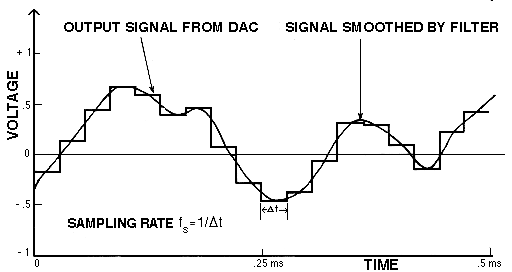The electronic production of sound where no acoustic source is used. An electrical SIGNAL is produced which is the analog of a SOUND WAVE; that is, the voltage fluctuation in the signal represents that of the desired SOUND PRESSURE variation. When this signal is fed to an AMPLIFIER and LOUDSPEAKER, the sound becomes an acoustic signal which behaves like any other sound.
Electronic equipment which can synthesize sound is often grouped into large units called SOUND SYNTHESIZERs. Some of these are designed for speech synthesis, but most are for ELECTRONIC MUSIC purposes. Before the advent of the synthesizer in the early 1960s, a body of techniques called classical studio technique developed other methods of sound synthesis:
- Additive synthesis describes the building up of a COMPLEX TONE or WAVEFORM from simpler elements such as SINE WAVEs according to the LAW OF SUPERPOSITION or FOURIER SYNTHESIS.
- Modulation synthesis and other non-LINEAR approaches involve the addition of SIDEBANDs as in FREQUENCY MODULATION, AMPLITUDE MODULATION and ring modulation (see MODULATION for sound examples).
- Subtractive synthesis describes the simplification of a complex waveform, such as WHITE NOISE, the SQUARE WAVE, or SAWTOOTH WAVE, by means of FILTERing.
Compare: MUSIQUE CONCRETE, SOUND OBJECT, TAPE MUSIC, TAPE RECORDER. See also: HETERODYNE.
A process called digital sound synthesis can also be used to produce sound by means of a computer. The computer is programmed to generate numbers or samples which describe the pressure function of the desired sound. These numbers are converted into voltage steps by a digital-to-analog converter (DAC), and subsequently smoothed into a continuous signal by a low-pass FILTER.
The number of samples per second that are produced to describe the sound signal is called the sampling rate. Its value determines the BANDWIDTH of the SPECTRUM which may be generated, since only frequencies less than or equal to half the sampling rate may be produced without a kind of distortion called foldover. Thus, a minimum of 40,000 numbers/second is required to reproduce audio frequencies up to 20 kHz. To account for the roll-off of the low-pass filter, standard sampling rates are 44.1 and 48 kHz. Each binary digit (or bit) used to represent the sample adds 6 dB to the DYNAMIC RANGE of the signal.
Digital sound synthesis is termed real-time when the samples are calculated at the same time as the sound is heard, or with a very short intervening delay. When the process involves intermediate storage of the samples (on digital MAGNETIC TAPE, for instance), the process is termed non-real-time.
See: DIGITAL RECORDING, DUBBING, GRANULAR SYNTHESIS. Compare: TRANSDUCER.
Ref.: M.V. Mathews, The Technology of Computer Music, The MIT Press, 1969; C. Roads, The Computer Music Tutorial, The MIT Press, 1996.

Production of a sound signal by digital synthesis. Numbers stored in the computer's memory are converted to discrete voltage steps by a digital-to-analog converter at fixed time intervals Dt, as shown above, along with the resultant signal smoothed by a low-pass filter.
home